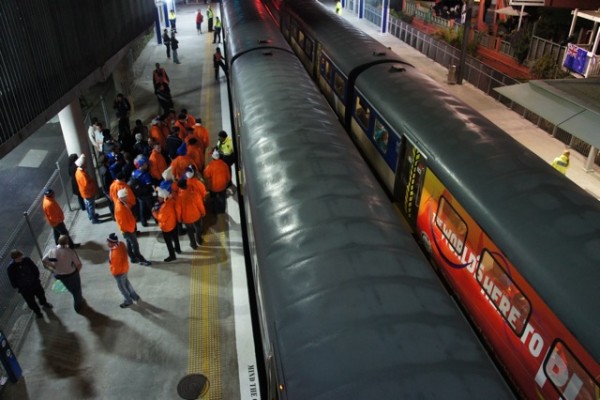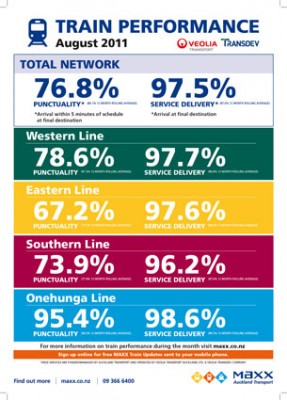Patronage Up Again
Here’s some good news about the Auckland train system - we need it after weeks of media outcry!
During August , one million passenger trips were recorded for the second month across the rail network.
In fact it’s good news for public transport patronage once again. August patronage was 6,576,129 passenger trips across public transport, an increase of 12.5% compared to August 2010.
For the 12-months to August 2011 patronage was 66,632,872 passenger trips, an increase of 8.8% compared to the 12-months to August 2010.
Public transport patronage continues to grow, with 66.6 million trips carried in the 12 months to August 2010, which was 8.8% higher than the previous 12 months
There’s no word yet on how the new LINK services, which came in on August 21, are doing.
But Auckland Transport says based on feedback so far, some changes to services to Freemans Bay are under consideration where there has been some concern about the lack of connections with Three Lamps and Karangahape Road.
Here is the latest performance brakdown for trains:
Veolia’s explanation is:
Of the 8,404 train services scheduled in August, 97.5 per cent arrived at their final destination and 76.8 per cent were on time.
- There was one major train breakdown during the month on Friday 5 August between Britomart and Newmarket, which resulted in nine services being delayed and two being cancelled.
- There were seven serious network failures all involving point and signal issues during the month. These occurred on 1 August near Glen Innes, 10 August at Papakura, 18 August at Otahuhu, and two on 22 August at Westfield and Otahuhu, the last on 26 August was also at Otahuhu. A total of 255 services were affected including 27 that were cancelled as a result. Veolia raised concerns about the signalling infrastructure at Otahuhu to KiwiRail and they are working through the network upgrades required to improve the system in time for Rugby World Cup.
- Emergency services responded to a report of smoke in a cab near The Strand on Wednesday 10 August. The situation was resolved quickly and resulted in only 221 delay minutes and five cancellations across the network.
- There was a fatality on the Western Line on Thursday 11 August which caused 26 delays and five cancellations.
On rail punctuality still being around 85%, Auckland Transport’s board papers this week offer this explanation:
While there have been a number of improvements across the rail network, there remains a great deal of work to complete as part of electrification. The installation of new signalling and overhead power supply has, and will continue to result in delays through temporary speed restrictions or track protection measures at each site.
While new signalling and train control is progressively being rolled out by KiwiRail, equipment failure is still encountered particularly on the sections that are yet to be upgraded or during bedding-in period for new equipment. The signalling system is currently installed from Britomart to Wiri on the Southern and Eastern Lines including Onehunga and from Britomart to Morningside on the Western Line.The services are also affected by a number of incidents that are beyond the control of the service provider. Recent examples include a freight train breakdown during the morning peak, fatalities on the rail corridor and road vehicles striking bridges or level crossing barriers. Such incidents result in a suspension of services or severe disruption. For cost efficiency purposes, crew rosters and train allocations are shared across all lines so when an incident on one part of the network delays a train crew this can lead to disruptions on other routes because the train or crew are not available to commence that run and there is limited spare resource available. In this case a single incident can be compounded when reflected in the
performance data. With a greater number of services now operating on the network, a single incident affecting one train will cause greater consequential delays to more trains than may have been evident in previous year when there were fewer trains scheduled.It is also noted that there are significant variances in the basis of the measurement of reliability and punctuality between train systems. Some types of delays are often excluded in published data for other rail operations and/or the measure may be based on departures and arrivals rather than the simple end arrival time used to measure the Auckland rail performance. This makes comparison between systems difficult with the Auckland methodology focused on arrival time only meaning it can be more onerous potentially than many other networks. The Auckland measurement is considered more onerous than Wellington for example where it is measured on 3 minutes from scheduled departure.
Notwithstanding the above, AT’s expectation is that rail punctuality will improve significantly, and to levels experienced by similar overseas systems, when the signalling and electrification projects are completed.
And to the question raised here several times as to why Onehunga’s performance is always the best of the Lines..
There are a number of reasons why the Onehunga Branch Line performance is better in comparison to the
rest of the network:
(a) For punctuality, the five minute definition for a train operating on time is a greater proportion of the total journey time for Onehunga services compared to other lines, the scheduled run time for Onehunga services is 25 minutes, therefore a 5 minute on-time definition in effect provides a 20% contingency whereas for other lines it is less than 20%. By comparison, the five minute definition applied to a train from Papakura with a run time of 53 minutes gives half the tolerance (9.4%) to delays encountered enroute(b) For lines other than Onehunga, there is a greater journey time, more stops and greater traffic density, which increases the risk of a single service being delayed in the course of its journey or being delayed by an incident or by an event affecting another train ahead.
(c) The completed upgrade of the Onehunga Branch Line has resulted in fewer network and infrastructure failures that can result in service cancellations compared with other routes. Performance on other lines due to network and infrastructure failures would expect to improve as the new signalling system is implemented.
And on why bus punctuality is self reported...
It is worth noting that rail punctuality data is also self-reported (not independently verified by a GPS system). Data is manually prepared by KiwiRail through their Operating Management System (OMS) and then Veolia verify this against data collected by on-train staff. Rail operates about 7,800 trips a month.
The new signalling system from 2012 will allow automated reporting of punctuality and reliability against schedule.
Bus punctuality is also self-reported, however, bus operations are around 180,000 trips per month so it is impractical to apply the same level of manual handling of data as for rail. The current GPS based RAPID system used to provide predictive arrival times across the bus network is undergoing an improvement plan to make the reliability suitable for full bus service performance management (it is currently used to identify areas of poor performance, which are then focused on manually to identify issues to improve performance).
This includes the replacement of all Electronic Ticketing Machines on buses through the AIFS programme to provide accurate data feeds to RAPID, improvement to SNAPPER Bus Driver Consoles to ensure that the driver correctly enters the route information and registers a route on the system and the rollout by Christmas 2011 of a RAPID software upgrade to track locations at a more granular frequency across the route. This upgrade will lead to automated reporting of bus punctuality from the RAPID system.













8 Comments
I was just reading that report before, glad to see someone finally asked some questions as to the performance numbers.
As for patronage, great to hear we broke the 1mil mark again, something that will likely start happening much more frequently in the coming years.
It’s a safe bet September will be well over the million mark. The question is by how much? 1.2? Is 1.5 stretching things a bit? Remember, it’s not just the RWC specials, it’s all the extra late night and weekend non-event services. Good be an interesting result!
Interesting comments regarding the bus performance stats. I’ve long distrusted the self-reported bus performance stats contained in the ARTA reports. The main reason being they usually show an unrealistic on-time rate (i.e. arrived at final destination no less than 5 [or 20] mins late) in the 99%+ range. This is in contrast to my actual experience (based on around ~500 bus trips a year) where only approx 60-70% of the bus trips I have taken have run as per schedule. Of course the bus schedules are padded so much that it’s possible that the buses do arrive at the destination on time despite departing the origin more than 5 mins late.
@Matt: I suspect it’ll not only happen more frequently but become the norm! The next aim should be for 1.5m pax a month.
James - I would say the next aim is to pass Wellington for annual train patronage, at current growth rates that could happen within the year but will definitely be the case by the time the EMU’s arrive.
John Key still stands up in public to say that rail use will be at the expense of bus use, er, John can you do basic math? If both figures are growing how can that be. Stupid or lying, which is it John?
I just don’t get it - report after report just justifies the need for this rail loop. Why are we waiting for it for so long? Are the people in Wellington getting these reports?
Johans - yes they get them but like to close their eyes, stick their fingers in their ears and think its all a mistake while imagining that this will still become a reality.
Well Onehunga puncuality is almost acceptable. Really 85% is still poor given that late means more than 5 minutes late.